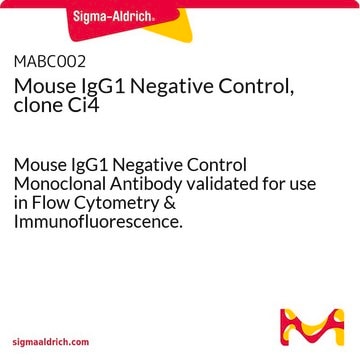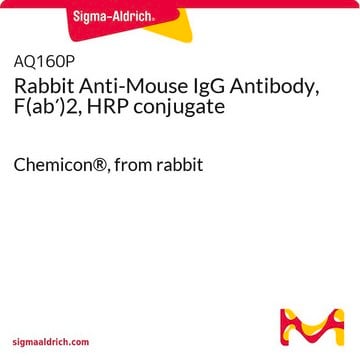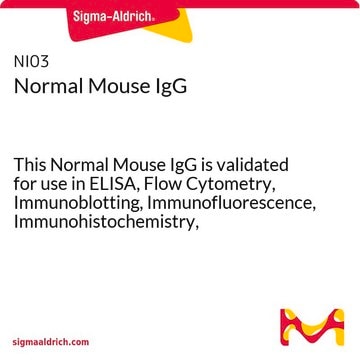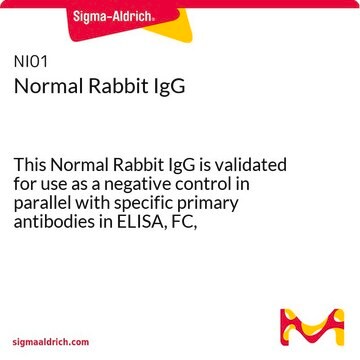CBL610
Mouse IgG1 Negative Control Antibody, clone 1E2.2
clone 1E2.2, 1 mg/mL, Chemicon®
Autenticatiper visualizzare i prezzi riservati alla tua organizzazione & contrattuali
About This Item
Codice UNSPSC:
12352203
eCl@ss:
32160702
NACRES:
NA.42
Prodotti consigliati
Origine biologica
mouse
Livello qualitativo
Forma dell’anticorpo
purified immunoglobulin
Clone
1E2.2, monoclonal
Produttore/marchio commerciale
Chemicon®
Concentrazione
1 mg/mL
tecniche
flow cytometry: suitable
Isotipo
IgG1κ
Condizioni di spedizione
wet ice
modifica post-traduzionali bersaglio
unmodified
Descrizione generale
Immunoglobulin G (IgG), is one of the most abundant proteins in human serum with normal levels between 8-17 mg/mL in adult blood. IgG is important for our defense against microorganisms and the molecules are produced by B lymphocytes as a part of our adaptive immune response. The IgG molecule has two separate functions; to bind to the pathogen that elicited the response and to recruit other cells and molecules to destroy the antigen. The variability of the IgG pool is generated by somatic recombination and the number of specificities in an individual at a given time point is estimated to be 1011 variants.
Specificità
This isotype control shows negligible cross-reactivity with human cell surface antigens on tissue sections or in cellular preparations. It therefore enables the estimation of non-specific binding of mouse monoclonals to cell surface antigens.
Applicazioni
Mouse IgG1 Negative Control Monoclonal Antibody validated for use in Flow Cytometry.
Research Category
Secondary & Control Antibodies
Secondary & Control Antibodies
Research Sub Category
Epitope Tags
Epitope Tags
Qualità
Evaluated by Flow Cytometry in HeLa cells.
Flow Cytometry Analysis: 2 µg of this antibody was used as a Mouse IgG1 Negative Control in staining of HeLa cells.
Flow Cytometry Analysis: 2 µg of this antibody was used as a Mouse IgG1 Negative Control in staining of HeLa cells.
Linkage
Replaces: CBL600
Stato fisico
Format: Purified
Protein G
Purified mouse monoclonal IgG1κ in buffer containing 0.1 M Tris-Glycine (pH 7.4), 150 mM NaCl with 0.05% sodium azide.
Stoccaggio e stabilità
Stable for 1 year at 2-8°C from date of receipt.
Risultati analitici
Control
HeLa cells
HeLa cells
Note legali
CHEMICON is a registered trademark of Merck KGaA, Darmstadt, Germany
Esclusione di responsabilità
Minimum order quantity required to qualify. Unless otherwise stated in our catalog or other company documentation accompanying the product(s), our products are intended for research use only and are not to be used for any other purpose, which includes but is not limited to, unauthorized commercial uses, in vitro diagnostic uses, ex vivo or in vivo therapeutic uses or any type of consumption or application to humans or animals.
Codice della classe di stoccaggio
12 - Non Combustible Liquids
Classe di pericolosità dell'acqua (WGK)
WGK 1
Punto d’infiammabilità (°F)
Not applicable
Punto d’infiammabilità (°C)
Not applicable
Certificati d'analisi (COA)
Cerca il Certificati d'analisi (COA) digitando il numero di lotto/batch corrispondente. I numeri di lotto o di batch sono stampati sull'etichetta dei prodotti dopo la parola ‘Lotto’ o ‘Batch’.
Possiedi già questo prodotto?
I documenti relativi ai prodotti acquistati recentemente sono disponibili nell’Archivio dei documenti.
I clienti hanno visto anche
Paul D Madge et al.
Scientific reports, 6, 36012-36012 (2016-11-04)
Siglec-2 undergoes constitutive endocytosis and is a drug target for autoimmune diseases and B cell-derived malignancies, including hairy cell leukaemia, marginal zone lymphoma, chronic lymphocytic leukaemia and non-Hodgkin's lymphoma (NHL). An alternative to current antibody-based therapies is the use of
Lilei Peng et al.
Oncology letters, 17(2), 2123-2130 (2019-02-06)
There is compelling evidence that brain tumors, particularly glioblastoma multiforme (GBM), harbor a small population of cancer stem cells (CSCs). These CSCs have the ability to undergo self-renewal, initiate tumors in vivo, and are resistant to chemotherapy and radiation therapy.
Tianfu Wang et al.
Communications biology, 7(1), 390-390 (2024-03-31)
Intervertebral disc degeneration (IDD) is a well-established cause of disability, and extensive evidence has identified the important role played by regulatory noncoding RNAs, specifically circular RNAs (circRNAs) and microRNAs (miRNAs), in the progression of IDD. To elucidate the molecular mechanism
PKCδ regulates integrin αVβ3 expression and transformed growth of K-ras dependent lung cancer cells.
Jennifer M Symonds et al.
Oncotarget, 7(14), 17905-17919 (2016-02-27)
We have previously shown that Protein Kinase C delta (PKCδ) functions as a tumor promoter in non-small cell lung cancer (NSCLC), specifically in the context of K-ras addiction. Here we define a novel PKCδ -> integrin αVβ3 ->Extracellular signal-Regulated Kinase
Shannon McNulty et al.
Journal of virology, 87(2), 912-922 (2012-11-09)
Hantavirus pulmonary syndrome (HPS) is a severe respiratory disease characterized by pulmonary edema, with fatality rates of 35 to 45%. Disease occurs following infection with pathogenic New World hantaviruses, such as Andes virus (ANDV), which targets lung microvascular endothelial cells.
Il team dei nostri ricercatori vanta grande esperienza in tutte le aree della ricerca quali Life Science, scienza dei materiali, sintesi chimica, cromatografia, discipline analitiche, ecc..
Contatta l'Assistenza Tecnica.








